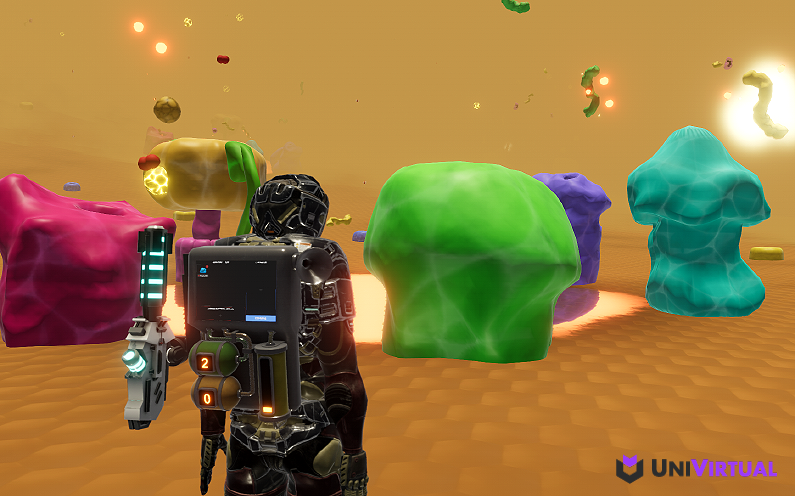From lifelike simulations to abstract worlds, virtual spaces help us visualize and interact with things we might never be able to otherwise.
In this blog, I’ll be reporting on how UniVirtual’s biology labs helped me understand the process of cellular respiration from an environment impossible to visit in reality: from inside an animal cell! There, I learned about complex processes by witnessing them first-hand.
Honey, I Shrunk My Students!
With my avatar donning their virtual lab coat, I started by visiting UniVirtual’s biology bench-lab. Part of the course requires students to write a post-lab report, so I’m sharing mine here.

Caption: The lab’s shrinking chamber. I stepped inside with my P.A.C.K, eager to shrink.
Biology Student Carolyn reporting:
My journey began in a simulation of a real-life bench lab. There, a daring researcher from the Biology department explained their newest creation to me: a shrinking chamber and suit powered by a device worn like a backpack, known as my Portable Absorption and Combination Kit, or P.A.C.K for short!
Together, these high-tech devices allowed me to shrink down to the size of a protein. From there, I was free to explore and interact with the inside of the animal cell the researcher had ready for me.

Caption: The cell’s interior, where my tour took place.
From the cell’s interior, I was given a guided tour of the main elements and metabolic reactions of cellular respiration. This tour showed me everything I needed to know about cellular respiration. It walked me through the reactions involved at all stages of cellular respiration. I witnessed these taking place in the environment and could interact with them. Tools like animations and labels helped me understand what I was looking at. However, once it was time to return to full size, the suit malfunctioned and ran out of energy! Fortunately, my P.A.C.K. could convert ATP (the energy currency of animal cells) into usable power that, if done correctly, was strong enough to return me to my normal size.
With this goal in mind, I put my knowledge of cellular respiration to the test by collecting reactants scattered all around the cell’s interior using my P.A.C.K’s tractor beam. My P.A.C.K contained the technology needed to combine these reactants, recreating each stage of respiration and providing me the energy I needed.
Doing this gave me a deeper understanding of how cells produce energy and the complex processes they use to do so. As I needed to visit certain areas of the cell to collect reactants and perform the processes, I learned where those processes occurred, what their products were, and how they interrelated.

Caption: My avatar seeking reactants within the mitochondria.
Now that I’ve returned to my normal size, I’m interested in how this gamified environment helped me learn effectively. I’ll hand-over to Mollie Braley, UniVirtual’s resident expert in making learning effective and fun, to explain.
Getting the Balance Right
Mollie here, and I’m glad to see that Carolyn made it out of the cell in one piece.
So, the question is how to make virtual learning effective yet still fun? Well, that’s a lot to cover, but I think I can summarize our main aspirations when converting traditional learning materials into virtual games and activities.
First off, we aim to make our environments as realistic and accurate as possible. One of the challenges with realism is making things accessible and relatable to students who have only seen cell interiors in textbook diagrams. To make a stronger learning connection, our cell environment uses visual aids that are recognizable to students, such as videos, animations, labels, and text/audio explanations.
As an example, students learn about the Electron Transport Chain inside the cell by experiencing it as a linear process when, in reality, each step happens simultaneously. Carolyn would’ve experienced both during her visit.
To provide her with an accurate view of this process, we provided two different views.

Caption: Labeled “Instructional View” of the Electron Transport Chain
One view is a labeled and narrated animation closely resembling textbook or educational videos students watch in their classes. We call this the “Instructional View.”
The other is the “Environmental View”, and this resembles what the process would look like if we could shrink ourselves down to the size of a protein. This repetition of the same concept, but in two different ways, helps students understand their experience more fully and gain a broader perspective on how things appear in real-life versus the classroom.

Caption: The “Environmental View” from inside the mitochondria.
Going Offline
Thank you for explaining, Mollie. In future posts, this blog will go into more detail about the game mechanics Mollie mentioned, so I better wrap up now before we spoil the surprise.
For now, I’ll say that I certainly won’t forget the unique experience of entering a cell’s mitochondria any time soon!

